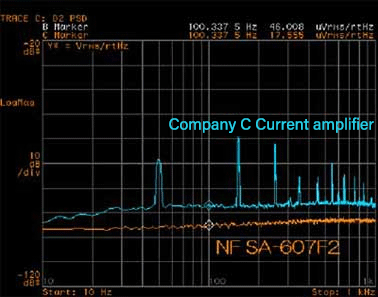Posted 2019/9/23
Output-noise voltage density characterristics of SA-607F2 and the I/V amplifier of company C are
shown in figure 8. SA-607F2: gain is 10 GV/A, upper cutoff frequency is 20 kHz. I/V amplifier of
company C: gain is 10 GV/A, upper cutoff frequency is 1.4 kHz.
The measurement-frequency range is 10 Hz to 1 kHz, which is passband of the I/V amplifier.
Figure 8: Comparison of output-noise voltage density
characteristics
[G = 10 GV/A; BW = 1 kHz (10 Hz to 1 kHz)]

*Investigation on June 16, 2017
It can be seen that the noise voltage density of SA-607F2 is 8 dB lower than I/V amplifier of company C (about 60% reduction). Also, I/V amplifier of company C has hum noise, but SA-607F2 dose not.
The reason why the SA-607F2 current amplifier has low noise is because the noise generated by the components that make up the current amplifier is very low. In general, the noise in the low frequency region of the current amplifier is determined by the thermal noise from the feedback resistor and the input equivalent noise current density of the first stage amplifier. The amplifier used in the NF’s SA-600 / CA-650 / CA-550 series is an original amplifier designed by combining discrete components to reduce noise.
Next, about the influence of hum noise.
Since the current amplifier of company C has a built-in power supply, hum noise is easily mixed.
On the other hand, since the NF SA-600 series can be installed away from the power supply, it is
possible to reduce mixed hum noise.
Related keywords : Ultra low noise amplifier, LNA